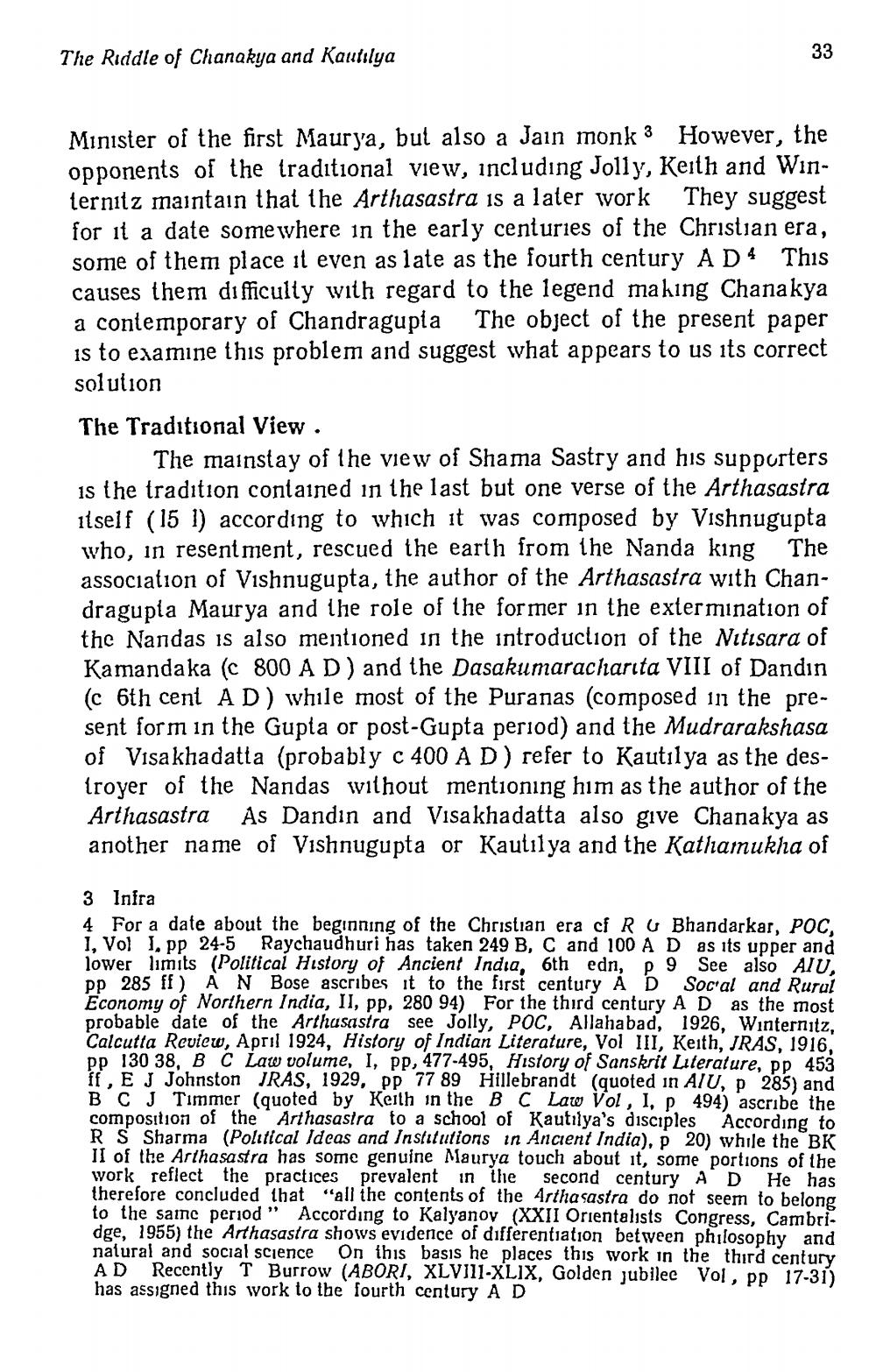________________
The Riddle of Chanakya and Kautilya
Minister of the first Maurya, but also a Jain monk 3 However, the opponents of the traditional view, including Jolly, Keith and Winternitz maintain that the Arthasastra is a later work They suggest for it a date somewhere in the early centuries of the Christian era, some of them place it even as late as the fourth century AD 4 This causes them difficulty with regard to the legend making Chanakya a contemporary of Chandragupta The object of the present paper is to examine this problem and suggest what appears to us its correct solution
The Traditional View .
The mainstay of the view of Shama Sastry and his supporters is the tradition contained in the last but one verse of the Arthasastra itself (15 l) according to which it was composed by Vishnugupta who, in resentment, rescued the earth from the Nanda king The association of Vishnugupta, the author of the Arthasastra with Chandragupta Maurya and the role of the former in the extermination of the Nandas is also mentioned in the introduction of the Nitisara of Kamandaka (c 800 AD) and the Dasakumaracharita VIII of Dandin (c 6th cent AD) while most of the Puranas (composed in the present form in the Gupta or post-Gupta period) and the Mudrarakshasa of Visakhadatta (probably c 400 AD) refer to Kautilya as the destroyer of the Nandas without mentioning him as the author of the Arthasastra As Dandin and Visakhadatta also give Chanakya as another name of Vishnugupta or Kautilya and the Kathamukha of
3 Infra 4 For a date about the beginning of the Christian era cf Ru Bhandarkar, POC, 1. Voll. pp 24-5 Raychaudhuri has taken 249 B, C and 100 AD as its upper and lower limits (Political History of Ancient India, 6th edn, P 9 See also AIU, DD 285 ff) À N Bose ascribes it to the first century A D Soc'al and Rural Economy of Northern India, II, pp. 280 94) For the third century AD as the most probable date of the Arthusastra see Jolly, POC, Allahabad, 1926. Winternutz Calcutta Review, April 1924, History of Indian Literature, Vol III, Keith, JRAS, 1916. pp 130 38, BC Law volume, I, pp, 477-495, History of Sanskrit Literature, pp 453 ff, E J Johnston JRAS, 1929, pp 77 89 Hillebrandt (quoted in AIU, P 285) and B C J Timmer (quoted by Keith in the B C Law Vol , 1, p 494) ascribe the composition of the Arthasasira to a school of Kautilya's disciples According to RS Sharma (Political Ideas and Institutions in Ancient India), p 20) while the BK II of the Arthasastra has some genuine Maurya touch about it, some portions of the work reflect the practices prevalent in the second century A D He has therefore concluded that "all the contents of the Artha sastra do not seem to belong to the same period” According to Kalyanov (XXII Orientalists Congress, Cambri. dge, 1955) the Arthasastra shows eviderice of differentiation between philosophy and natural and social science On this basis he places this work in the third century AD Recently T Burrow (ABORI, XLV111-XLIX, Golden Jubilee Vol , pp 17-31) has assigned this work to the fourth century AD




